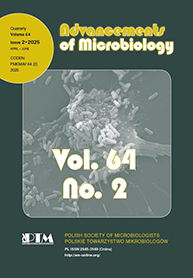1. Wprowadzenie. 2. Taksonomia. 3. Chorobotwórczość S. intermedius i S. pseudintermedius. 4. Cytolizyny gronkowców. 4.1. Hemolizyna α. 4.2. Hemolizyna β. 4.3. Hemolizyna δ. 4.4. Hemoliza synergistyczna. 4.5. Hemolizyna γ. 4.6. Leukocydyny. 5. Podsumowanie
Abstract: Bacteria in the Staphylococcus genus are one of the most abundant in the human microbiome. In addition to S. aureus, coagulase-positive group includes other species, such as isolated from animals S. intermedius and S. pseudintermedius. Recently, these two species have been also isolated from clinical materials from humans with increasing frequency. Apart from wound infections caused by animal bites, S. intermedius and S. pseudintermedius are also an etiological agent of endocarditis, central nervous system infections or bacteremia. Both species produce cytolysins: hemolysins α, β, δ, γ and leukocidins which have the ability to damage not only erythrocytes, but also many eukaryotic cells. Thus, these toxins seem to be very important virulence factors. In the light of the recent studies indicating participation of cytolysins in inflammatory processes and formation of biofilms, toxins produced by these species seem to be of particular importance in the pathogenesis of infections.
1. Introduction. 2. Taxonomy. 3. Pathogenicity of S. intermedius and S. pseudintermedius. 4. Staphylococcal cytolysins. 4.1. Hemolysin α. 4.2. Hemolysin β. 4.3. Hemolysin δ. 4.4. Synergistic hemolysis. 4.5. Hemolysin γ. 4.6. Leukocodins. 5. Summary

